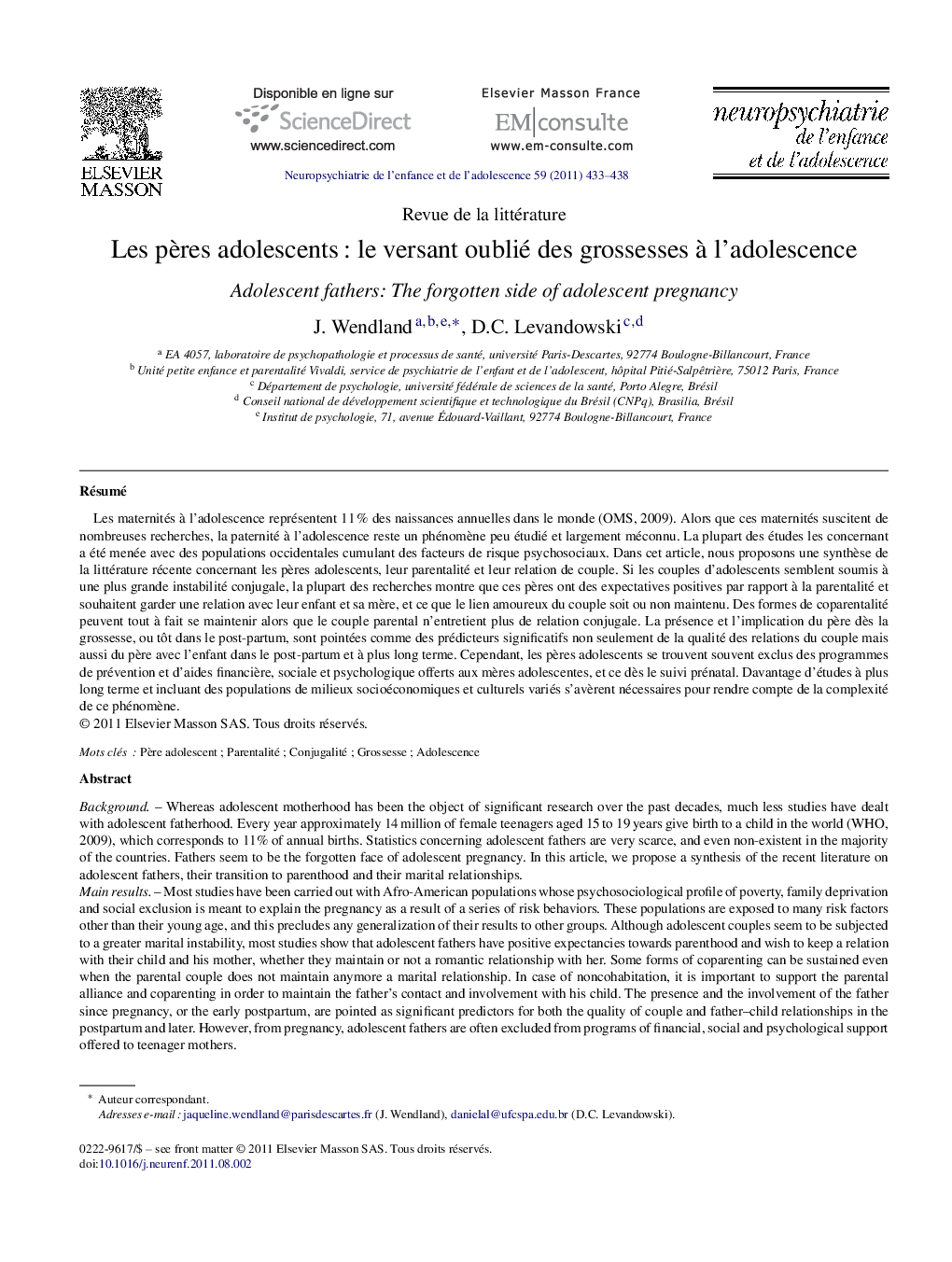| کد مقاله | کد نشریه | سال انتشار | مقاله انگلیسی | نسخه تمام متن |
|---|---|---|---|---|
| 944183 | 925585 | 2011 | 6 صفحه PDF | دانلود رایگان |

RésuméLes maternités à l’adolescence représentent 11 % des naissances annuelles dans le monde (OMS, 2009). Alors que ces maternités suscitent de nombreuses recherches, la paternité à l’adolescence reste un phénomène peu étudié et largement méconnu. La plupart des études les concernant a été menée avec des populations occidentales cumulant des facteurs de risque psychosociaux. Dans cet article, nous proposons une synthèse de la littérature récente concernant les pères adolescents, leur parentalité et leur relation de couple. Si les couples d’adolescents semblent soumis à une plus grande instabilité conjugale, la plupart des recherches montre que ces pères ont des expectatives positives par rapport à la parentalité et souhaitent garder une relation avec leur enfant et sa mère, et ce que le lien amoureux du couple soit ou non maintenu. Des formes de coparentalité peuvent tout à fait se maintenir alors que le couple parental n’entretient plus de relation conjugale. La présence et l’implication du père dès la grossesse, ou tôt dans le post-partum, sont pointées comme des prédicteurs significatifs non seulement de la qualité des relations du couple mais aussi du père avec l’enfant dans le post-partum et à plus long terme. Cependant, les pères adolescents se trouvent souvent exclus des programmes de prévention et d’aides financière, sociale et psychologique offerts aux mères adolescentes, et ce dès le suivi prénatal. Davantage d’études à plus long terme et incluant des populations de milieux socioéconomiques et culturels variés s’avèrent nécessaires pour rendre compte de la complexité de ce phénomène.
BackgroundWhereas adolescent motherhood has been the object of significant research over the past decades, much less studies have dealt with adolescent fatherhood. Every year approximately 14 million of female teenagers aged 15 to 19 years give birth to a child in the world (WHO, 2009), which corresponds to 11% of annual births. Statistics concerning adolescent fathers are very scarce, and even non-existent in the majority of the countries. Fathers seem to be the forgotten face of adolescent pregnancy. In this article, we propose a synthesis of the recent literature on adolescent fathers, their transition to parenthood and their marital relationships.Main resultsMost studies have been carried out with Afro-American populations whose psychosociological profile of poverty, family deprivation and social exclusion is meant to explain the pregnancy as a result of a series of risk behaviors. These populations are exposed to many risk factors other than their young age, and this precludes any generalization of their results to other groups. Although adolescent couples seem to be subjected to a greater marital instability, most studies show that adolescent fathers have positive expectancies towards parenthood and wish to keep a relation with their child and his mother, whether they maintain or not a romantic relationship with her. Some forms of coparenting can be sustained even when the parental couple does not maintain anymore a marital relationship. In case of noncohabitation, it is important to support the parental alliance and coparenting in order to maintain the father's contact and involvement with his child. The presence and the involvement of the father since pregnancy, or the early postpartum, are pointed as significant predictors for both the quality of couple and father–child relationships in the postpartum and later. However, from pregnancy, adolescent fathers are often excluded from programs of financial, social and psychological support offered to teenager mothers.ConclusionsStudies on adolescent fathers are still very few and often affected by a negative vision, which does not account for the diversity of situations. More research is needed on this topic, including a longitudinal design and populations of multiple socio-economic and cultural background. Lastly, it appears imperative to offer them the same programs of prevention and material and psychological support that those proposed to teenager mothers, in order to encourage their involvement since the antenatal period, as recommended by WHO.
Journal: Neuropsychiatrie de l'Enfance et de l'Adolescence - Volume 59, Issue 7, November 2011, Pages 433–438